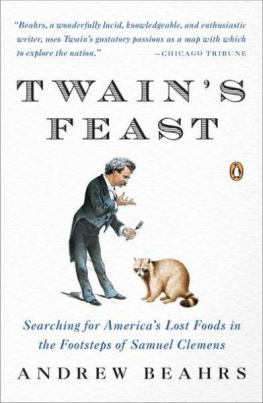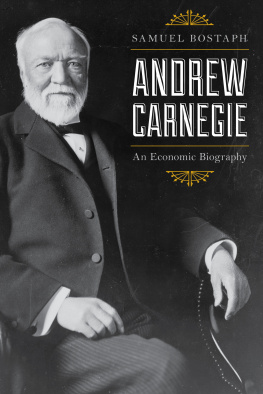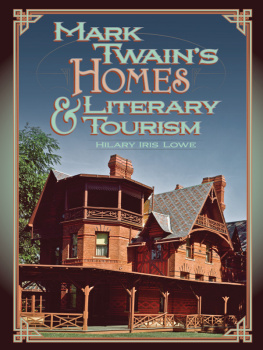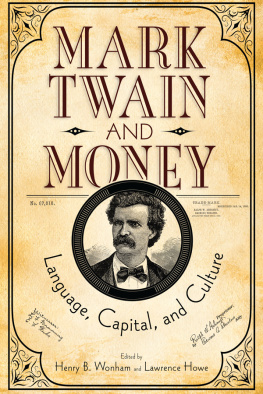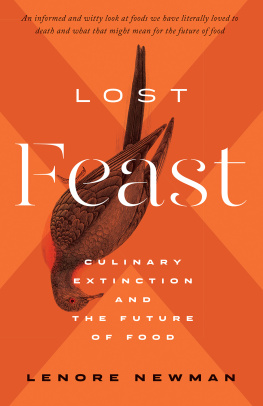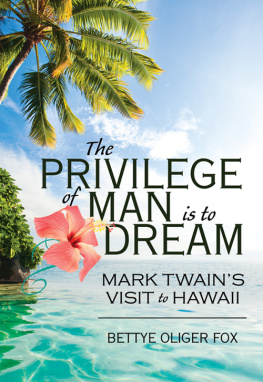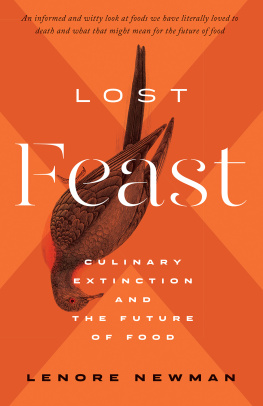ACKNOWLEDGMENTS
Many people shared their work and knowledge during the writing of this book. Im particularly grateful to the following: Frank and Judy Oberle, John and Linda Cover, Frank and Helen Wolfe, Robert Eagle, Rena Obernolte, Bud Abbott, Marguerite Whilden, Tory McPhail, Cliff Hall, Jannette Vanderhoop, Bret Stearns, Kristine and Robert Keese, Jim Dina, and Bill and Amy Proulx. Thanks also to Dianne Jacob, Scott Simpson, Terry Esker, Vernon Kleen, Ronald Westemeier, Jay Miller, Sumadu Welaratna, Marilyn Latta, Hilary Sandler, Linda Coombs, Patti Phillippon, Lydia Matthias, Lisa Monachelli, Kay Carroll, Craig Borges, Nancy Rabelais, Kevin Craig, Ray and Kay Brandhurt, Pete and Clara Gerica, Poppy Tooker, Barbara Brennessel, Darra Goldstein, Sandra Oliver, and Cameron Monroe.
The staff at the Mark Twain Project, headed up by Robert Hirst at Berkeleys Bancroft Library, deserves special mention: Neda Salem, Vic Fischer, Michael Frank, and Lin Salamo were all welcoming and enormously helpful from the first day I came knocking. Im grateful for their dedication to sharing their remarkable depth of knowledge about Twain, as well as for their infectious enthusiasm.
Paula Marcoux and Pret Woodburn, Terry and Lynn Myers, Bill and Chris Merritt, and Dora, Paul, and Reilly Cullen were all terrific hosts, and often sources in their own rightI hope to be able to return the hospitality to each of you soon. Thanks also to Cameron, Stephanie, Angela, Miranda, Ryan, Dave, Karin, Brio, Nathan, and Natalie, for the steady support (and for sharing a last celebratory lunch).
Im tremendously fortunate in my agent, Emma Sweeney, and my editor, Laura Stickney. Emmas enthusiasm, encouragement, and guidance continued long after she found the book its best possible home. Laura has been a constantly insightful, focused, and dedicated presence; Im very grateful for her sharp eye, steady hand, and sure instincts.
I can never thank my family enough for their help and support during the writing of a book that overlapped, in large measure, with my daughters first year. Eli, Erik, and Mio were terrific cheerleaders, research partners, and occasional travel companions; when I did go without them, the best part was always coming home.
Finally, I have to acknowledge my great gratitude to Samuel Clemens for his lifetime of inspiring work. His words are as full of life as when he wrote them; the world is a better place for having had him in it.
SELECTED BIBLIOGRAPHY
IN ADDITION TO THE following and the sources cited in the notes, two magnificent online resources were indispensable while writing this book: the Mark Twain Project Online (www.marktwainproject.org), an extensiveand constantly growingarchive of Twains correspondence and work, and also the wonderful collection of vintage cookbooks made available by the Feeding America Project at the Michigan State University Library (http://digital.lib.msu.edu/projects/cookbooks/index.html).
Microfilm Edition of Mark Twains Manuscript Letters Now in the Mark Twain Papers. Bancroft Library, University of California, Berkeley, 2001.
Baker, James W. Thanksgiving: The Biography of an American Holiday. Durham: University of New Hampshire Press, 2009.
Barrett, Elinore M. The California Oyster Industry. Scripps Institution of Oceanography Library, Fish Bulletin 123, 1963.
Behnke, Robert J. Trout and Salmon of North America. New York: Free Press, 2002.
Benyus, Janine. Biomimicry: Innovation Inspired by Nature. New York: Harper Perennial, 1997.
Berry, John M. Rising Tide: The Great Mississippi Flood of 1927 and How It Changed America. New York: Simon & Schuster, 1997.
Bower, Anne L., ed. African American Foodways: Explorations of History and Culture. Urbana: University of Illinois Press, 2007.
Brennessel, Barbara. Diamonds in the Marsh: A Naural History of the Diamondback Terrapin. Hanover, NH: University Press of New England, 2006.
Brillat-Savarin, Jean Anthelme. The Physiology of Taste; or, Meditations on Transcendental Gastronomy. M.F.K. Fisher, trans. New York: Harcourt Brace Jovanovich, 1949 (1825).
Burk, John, and Marjorie Holland. Stone Walls and Sugar Maples: An Ecology for Northeasterners. Boston: Appalachian Mountain Club, 1979.
Carney, Judith A. Black Rice: The African Origins of Rice Cultivation in the Americas. Cambridge, MA: Harvard University Press, 2001.
Carter, Susannah. The Frugal Housewife. New York: G. & R. Waite, 1803.
Child, Lydia Maria Francis. The Frugal Housewife. Boston: Carter and Hendee, 1830.
Corson, Juliet. Practical American Cookery and Household Management. New York: Dodd, Mead, 1886.
Curtin, Kathleen, Sandra Oliver, and Plimoth Plantation. Giving Thanks: Thanksgiving Recipes and History, from Pilgrims to Pumpkin Pie. New York: Clarkson Potter, 2005.
Cutter, Ralph. Sierra Trout Guide. Portland, OR: Frank Amato Publications, 1991.
Davidson, Alan. The Penguin Companion to Food. New York: Penguin, 1999.
Deetz, James. Flowerdew Hundred: The Archaeology of a Virginia Plantation, 1619-1864. Charlottesville: University Press of Virginia, 1993.
. In Small Things Forgotten: An Archaeology of Early American Life, 2nd ed. New York: Doubleday/ Anchor, 1996.
, and Patricia Scott Deetz. The Times of Their Lives: Life, Love, and Death in the Plymouth Colony. New York: W. H. Freeman, 2000.
Eagleston, Janet, and Rosemary Hasner. The Maple Syrup Book. Boston: Boston Mills Press, 2006.
Eck, Paul. The American Cranberry. New Brunswick and London: Rutgers University Press, 1990.
Edwords, Clarence E. Bohemian San Francisco: Its Restaurants and Their Most Famous Recipes. San Francisco: Silhouette Press, 1973 (1914).
Emerson, Everett. Mark Twain: A Literary Life. Philadelphia: University of Pennsylvania Press, 2000.
Ferguson, Leland. Uncommon Ground: Archaeology and Early African America, 1650-1800. Washington, D.C.: Smithsonian Institution Press, 1992.
Fishkin, Shelley Fisher. Was Huck Black? Mark Twain and African-American Voices. New York: Oxford University Press, 1993.
Franklin, Maria. The Archaeological and Symbolic Dimensions of Soul Food: Race, Culture and Afro-Virginian Identity. In Race and the Archaeology of Identity, Charles Orser, ed. Salt Lake City: University of Utah Press, 2001, 88-107.
Gomez, Gay. The Louisiana Coast: Guide to an American Wetland. College Station: Texas A&M University Press, 2008.
Hall, Gwendolyn Midlo. Africans in Colonial Louisiana: The Development of Afro-Creole Culture in the Eighteenth Century. Baton Rouge and London: Louisiana State University Press, 1992.
Hall, Robert L. Food Crops, Medicinal Plants, and the Atlantic Slave Trade. In African American Foodways: Explorations of History and Culture, Anne L. Bower, ed. Urbana: University of Illinois Press, 2007, 17-44.
Hallowell, Christopher. Holding Back the Sea: The Struggle on the Gulf Coast to Save America. New York: Harper Perennial, 2001.
Hamerstrom, Frances. Strictly for the Chickens. Ames: Iowa State University Press, 1980.
Harran, Mark. Edible Traditions: Return of a Sugarbush Native. In Edible Nutmeg, Winter 2006, 22-27.
Harris, Jessica. The Welcome Table: African-American Heritage Cookery. New York: Simon & Schuster, 1995.
Hart, John. San Francisco Bay: Portrait of an Estuary. Berkeley: University of California Press, 2003.
Hess, Karen. The Carolina Rice Kitchen: The African Connection

